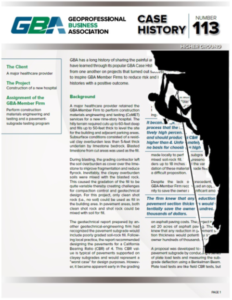New Case History: Higher Ground
GBA Geotechnical Business Committee
GBA has a long history of sharing the painful and expensive lessons its Member Firms have  learned through its popular GBA Case History series. Member Firms can also learn from one another on projects that turned out successfully. Higher Ground is intended to inspire GBA Member Firms to reduce risk and improve performance through case histories with a positive outcome.
learned through its popular GBA Case History series. Member Firms can also learn from one another on projects that turned out successfully. Higher Ground is intended to inspire GBA Member Firms to reduce risk and improve performance through case histories with a positive outcome.
In this Case History, a GBA-Member Firm performed construction materials engineering and testing (CoMET) services for a new nine-story hospital. Another firm’s geotechnical report recognized the pavement subgrade would include poorly graded soil-rock fill and recommended a bearing ratio that the GBA Member Firm recognized as a “worst case” for design purposes. It became apparent early in the grading process that the fill should produce a higher bearing ratio. This conclusion, based on field observations made during construction, proved to be correct. Despite a lack of precedent, the GBA-Member Firm recognized an opportunity to save the owner a significant amount on asphalt paving costs by reducing pavement section thickness. This resulted in hundreds of thousands of dollars of savings.
The result fostered a great relationship with a new client. Unfortunately, the Member Firm overlooked an opportunity to be fairly compensated for the additional risk and value derived.
Lessons learned include:
- Be sure you are right – then go ahead!

- Share and share alike.
- Understand the Standard of Care
- Conformation-dependent recommendations are important.
GBA case histories give all GBA-Member Firms an opportunity to conduct lunch-and-learn sessions, where participants– especially less experienced personnel –read the cases, then discuss what went wrong or right, and how to deal with similar issues in the future.
GBA-Member Firms use case histories to learn from others’ misfortunes, so you don’t have to learn through misfortunes of your own!
Case Histories are FREE for all GBA Members
Download Case History #113: HERE